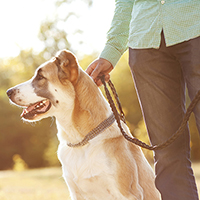Blastomycosis is a systemic disease which is caused by the fungus, Blastomyces dermatitidis. This fungal infection primarily affects dogs and humans. In humans, the disease is called "Chicago Disease", "Gilchrist Disease" or "Mycosis".
The primary mode of transmission of Blastomycosis is through inhalation of the fungal spores. The fungus abounds in the environment-in bodies of water and in the soil-thus most infections occur in dogs which spend a considerable amount of time outdoors. It has been observed that there is a high incidence of Blastomycosis in intact male dogs and large breed dogs. The disease has also been observed to commonly occur in dogs between the ages of 1-5 years old. Certain breeds of dogs are predisposed to the infection. These dog breeds include Labrador Retrievers, Golden Retrievers, Doberman Pinschers, Coonhounds, Pointers, Cocker Spaniels, and Weimaraners.
Once the spores enter the dog's airways, it stays in the lungs where the infection commences. As the organism multiplies, it spreads to the vascular system and/or lymph nodes.
Blastomycosis infection in dogs is manifested initially by a gradual loss of appetite followed by intermittent fever, weight loss, and depression. Coughing may also be present and usually gets worse as the disease progresses. By this time, the infection may have spread to the nervous system, bones, lymph nodes and skin.
Studies and clinical observations have shown that Blastomycosis is mainly manifested as a respiratory infection. A thorough physical examination may reveal enlarged lymph nodes, fever, abnormal lung sounds, skin lesions, nasal discharge, coughing, eye problems such as uveitis, glaucoma, retinal detachment, and chorioretinitis, tachypnea, nervous signs, and abnormal mass growths in the mammary gland, soft tissues, and vulva.
Aside from the physical manifestations of the disease, diagnosis is made based on a complete history and a thorough medical check-up. Your veterinarian will also recommend specific laboratory tests such as complete blood count and biochemical profile. Hypoalbuminemia is the usual result followed by hyperglobulinemia, and hypercalcemia. Radiographic examination of the chest may reveal the so-called "snowstorm pattern" which describes the growth of the yeast. Microscopic examination and staining of cytologic samples can also be done to identify the fungus. Other diagnostic tests which may be conducted include transtracheal wash (TTW), bronchoalveolar lavage (BAL), or fine needle aspiration (FNA) of the lung tissue.
Early detection is very important to prevent the onset of serious complications. The treatment regimen for Blastomycosis includes antifungal medication such as itraconazole, amphotericin-B, Ketoconazole, and Prednisone.
There is no vaccine which can protect your dog against Blastomycosis. In areas where the disease is endemic, limiting the amount of time that your dog spends outside, particularly around bodies of water may help reduce the incidence.
Knowing the early signs of Blastomycosis in dogs and seeking early veterinary attention can increase the chances of a favorable prognosis.

 12 Things Every Puppy Owner Should Know
12 Things Every Puppy Owner Should Know
12 Things Every Puppy Owner Should Know
12 Things Every Puppy Owner Should Know
 The Best Dry Dog Foods for Nutrition
The Best Dry Dog Foods for Nutrition
T
The Best Dry Dog Foods for Nutrition
The Best Dry Dog Foods for Nutrition
T
 Can Dogs Eat Watermelon?
Everybody loves watermelon, even
Can Dogs Eat Watermelon?
Everybody loves watermelon, even
 What is a responsible dog breeder?
Imagine yourself as an average pers
What is a responsible dog breeder?
Imagine yourself as an average pers
 What to Expect in the First Year After you Adopt a Puppy
What to Expect in the First Year After you Ad
What to Expect in the First Year After you Adopt a Puppy
What to Expect in the First Year After you Ad